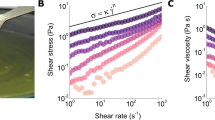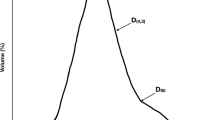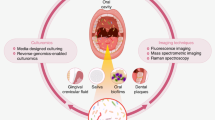Abstract
Food texture, along with taste and odour, is an important factor in determining food flavour. However, the physiological properties of oral texture perception require greater examination and definition. Here we explore recent trends and perspectives related to mouthfeel and its relevance in food flavour perception, with an emphasis on the biophysical point of view and methods. We propose that atomic force microscopy, combined with other biophysical techniques and more traditional food science approaches, offers a unique opportunity to study the mechanisms of mouthfeel at cellular and molecular levels. With this knowledge, food composition could be modified to develop healthier products by limiting salt, sugar, fat and calories while maintaining sensory qualities and consumer acceptance.
This is a preview of subscription content, access via your institution
Access options
Access Nature and 54 other Nature Portfolio journals
Get Nature+, our best-value online-access subscription
$29.99 / 30 days
cancel any time
Subscribe to this journal
Receive 12 digital issues and online access to articles
$119.00 per year
only $9.92 per issue
Buy this article
- Purchase on Springer Link
- Instant access to full article PDF
Prices may be subject to local taxes which are calculated during checkout



Similar content being viewed by others
References
Szczesniak, A. S. Texture is a sensory property. Food Qual. Prefer. 13, 215–225 (2002).
Kravchuk, O., Torley, P. & Stokes, J. R. in Food Materials Science and Engineering (eds Bhandari, B. & Roos, Y. H.) 349–372 (Wiley, 2012).
Stribiţcaia, E., Evans, C. E. L., Gibbons, C., Blundell, J. & Sarkar, A. Food texture influences on satiety: systematic review and meta-analysis. Sci. Rep. 10, 12929 (2020).
Agorastos, G. Review of mouthfeel classification: a new perspective of food perception. J. Food Sci. Nutr. https://doi.org/10.46715/jfsn2020.09.1000107 (2020).
Gogoi, B. J. Changing consumer preferences: factors influencing choice of fast food outlet. Acad. Mark. Stud. J. 24, 1–17 (2020).
Kim, M., Heo, G. & Kim, S.-Y. Neural signalling of gut mechanosensation in ingestive and digestive processes. Nat. Rev. Neurosci. 23, 135–156 (2022).
Wang, L. et al. Structure and mechanogating of the mammalian tactile channel PIEZO2. Nature 573, 225–229 (2019).
Righi, A. et al. Merkel cells in the oral mucosa. Int. J. Surg. Pathol. 14, 206–211 (2006).
Moayedi, Y., Duenas-Bianchi, L. F. & Lumpkin, E. A. Somatosensory innervation of the oral mucosa of adult and aging mice. Sci. Rep. 8, 9975 (2018).
Uhlén, M. et al. Tissue-based map of the human proteome. Science 347, 1260419 (2015).
Millet, J. R. M., Romero, L. O., Lee, J., Bell, B. & Vásquez, V. C. elegans PEZO-1 is a mechanosensitive ion channel involved in food sensation. J. Gen. Physiol. 154, e202112960 (2022).
Delmas, P. & Coste, B. SnapShot: orofacial sensation. Cell 183, 284–284.e1 (2020).
Chalfie, M. Neurosensory mechanotransduction. Nat. Rev. Mol. Cell Biol. 10, 44–52 (2009).
Toft-Bertelsen, T. L. & MacAulay, N. TRPing on cell swelling—TRPV4 senses it. Front. Immunol. 12, 730982 (2021).
Haggard, P. & de Boer, L. Oral somatosensory awareness. Neurosci. Biobehav. Rev. 47, 469–484 (2014).
Moayedi, Y. et al. The cellular basis of mechanosensation in mammalian tongue. Cell Rep. 42, 112087 (2023).
Moayedi, Y., Michlig, S., Park, M., Koch, A. & Lumpkin, E. A. Somatosensory innervation of healthy human oral tissues. J. Comp. Neurol. 529, 3046–3061 (2021).
Rolls, E. T. Taste, olfactory, and food texture processing in the brain, and the control of food intake. Physiol. Behav. 85, 45–56 (2005).
Burbidge, A. S. & Le Révérend, B. J. D. Biophysics of food perception. J. Phys. D 49, 114001 (2016).
Shi, Y., Sezgin, E. & Chen, W. Editorial: the role of biomembranes and biophysics in immune cell signaling. Front. Immunol. 12, 740373 (2021).
Sunshine, H. & Iruela-Arispe, M. L. Membrane lipids and cell signaling. Curr. Opin. Lipidol. 28, 408–413 (2017).
Amin, D. N. & Hazelbauer, G. L. Influence of membrane lipid composition on a transmembrane bacterial chemoreceptor. J. Biol. Chem. 287, 41697–41705 (2012).
Guinard, J.-X. & Mazzucchelli, R. The sensory perception of texture and mouthfeel. Trends Food Sci. Technol. 7, 213–219 (1996).
Stokes, J. R., Boehm, M. W. & Baier, S. K. Oral processing, texture and mouthfeel: from rheology to tribology and beyond. Curr. Opin. Colloid Interface Sci. 18, 349–359 (2013).
Koç, H., Vinyard, C. J., Essick, G. K. & Foegeding, E. A. Food oral processing: conversion of food structure to textural perception. Annu. Rev. Food Sci. Technol. 4, 237–266 (2013).
Canon, F., Neiers, F. & Guichard, E. Saliva and flavor perception: perspectives. J. Agric. Food Chem. 66, 7873–7879 (2018).
Yang, C. et al. Mechanical dynamics in live cells and fluorescence-based force/tension sensors. Biochim. Biophys. Acta 1853, 1889–1904 (2015).
Dumitru, A. C. & Koehler, M. Recent advances in the application of atomic force microscopy to structural biology. J. Struct. Biol. 215, 107963 (2023).
Koehler, M. et al. Control of ligand-binding specificity using photocleavable linkers in AFM force spectroscopy. Nano Lett. 20, 4038–4042 (2020).
Wildling, L. et al. Linking of sensor molecules with amino groups to amino-functionalized AFM tips. Bioconjug. Chem. 22, 1239–1248 (2011).
Saha, P., Duanis‐Assaf, T. & Reches, M. Fundamentals and applications of fluidFM technology in single‐cell studies. Adv. Mater. Interfaces 7, 2001115 (2020).
Koehler, M. et al. Reovirus directly engages integrin to recruit clathrin for entry into host cells. Nat. Commun. 12, 2149 (2021).
Dumitru, A. C. et al. Submolecular probing of the complement C5a receptor–ligand binding reveals a cooperative two-site binding mechanism. Commun. Biol. 3, 786 (2020).
Koehler, M. et al. Glycan-mediated enhancement of reovirus receptor binding. Nat. Commun. 10, 4460 (2019).
Koehler, M., Farka, D., Yumusak, C., Sariciftci, N. S. & Hinterdorfer, P. Localizing binding sites on bioconjugated hydrogen‐bonded organic semiconductors at the nanoscale. ChemPhysChem 21, 659–666 (2020).
Oh, Y. J. et al. Ultra-sensitive and label-free probing of binding affinity using recognition imaging. Nano Lett. 19, 612–617 (2018).
Dickinson, E. Colloids in food: ingredients, structure, and stability. Annu. Rev. Food Sci. Technol. 6, 211–233 (2015).
Dufrene, Y. F., Martinez-Martin, D., Medalsy, I., Alsteens, D. & Muller, D. J. Multiparametric imaging of biological systems by force-distance curve-based AFM. Nat. Methods 10, 847–854 (2013).
Liu, S. & Wang, Y. in Advances in Food and Nutrition Research Vol. 62 (ed. Taylor, S. L.) 201–240 (Academic Press, 2011).
Gaub, B. M. & Müller, D. J. Mechanical stimulation of Piezo1 receptors depends on extracellular matrix proteins and directionality of force. Nano Lett. 17, 2064–2072 (2017).
Krieg, M. et al. Atomic force microscopy-based mechanobiology. Nat. Rev. Phys. 1, 41–57 (2019).
Hunter, S. R. & Dalton, P. H. The need for sensory nutrition research in individuals with smell loss. Clin. Nutr. Open Sci. 46, 35–41 (2022).
Bassi, G., Grimaudo, M. A., Panseri, S. & Montesi, M. Advanced multi-dimensional cellular models as emerging reality to reproduce in vitro the human body complexity. Int. J. Mol. Sci. 22, 1195 (2021).
Liszt, K. I. et al. Caffeine induces gastric acid secretion via bitter taste signaling in gastric parietal cells. Proc. Natl Acad. Sci. USA 114, E6260–E6269 (2017).
Kutter, A., Hanesch, C., Rauh, C. & Delgado, A. Impact of proprioception and tactile sensations in the mouth on the perceived thickness of semi-solid foods. Food Qual. Prefer. 22, 193–197 (2011).
Simons, C. T., Klein, A. H. & Carstens, E. Chemogenic subqualities of mouthfeel. Chem. Senses 44, 281–288 (2019).
Delius, J., Médard, G., Kuster, B. & Hofmann, T. Effect of astringent stimuli on salivary protein interactions elucidated by complementary proteomics approaches. J. Agric. Food Chem. 65, 2147–2154 (2017).
Dunkel, A. & Hofmann, T. Carbonic anhydrase|IV mediates the fizz of carbonated beverages. Angew. Chem. Int. Ed. 49, 2975–2977 (2010).
Matjaž, P., Shuo, M., Gino, F., Markus, S. & Sanne, B. Smells like fat: a systematic scoping review on the contribution of olfaction to fat perception in humans and rodents. Food Qual. Prefer. 107, 104847 (2023).
Galindo, M. M. et al. G protein–coupled receptors in human fat taste perception. Chem. Senses 37, 123–139 (2012).
Acknowledgements
We acknowledge support for the research for this work from the Leibniz Association through the Leibniz Best Minds programme (M.K., grant number J112/2021).
Author information
Authors and Affiliations
Contributions
All authors participated in drafting and revising the paper, providing intellectual content and approving the final version for submission.
Corresponding author
Ethics declarations
Competing interests
The authors declare no competing interests.
Peer review
Peer review information
Nature Food thanks Jason Stokes, Emanuele Zannini and the other, anonymous, reviewer(s) for their contribution to the peer review of this work.
Additional information
Publisher’s note Springer Nature remains neutral with regard to jurisdictional claims in published maps and institutional affiliations.
Rights and permissions
Springer Nature or its licensor (e.g. a society or other partner) holds exclusive rights to this article under a publishing agreement with the author(s) or other rightsholder(s); author self-archiving of the accepted manuscript version of this article is solely governed by the terms of such publishing agreement and applicable law.
About this article
Cite this article
Koehler, M., Benthin, J., Karanth, S. et al. Biophysical investigations using atomic force microscopy can elucidate the link between mouthfeel and flavour perception. Nat Food 5, 281–287 (2024). https://doi.org/10.1038/s43016-024-00958-3
Received:
Accepted:
Published:
Issue Date:
DOI: https://doi.org/10.1038/s43016-024-00958-3



